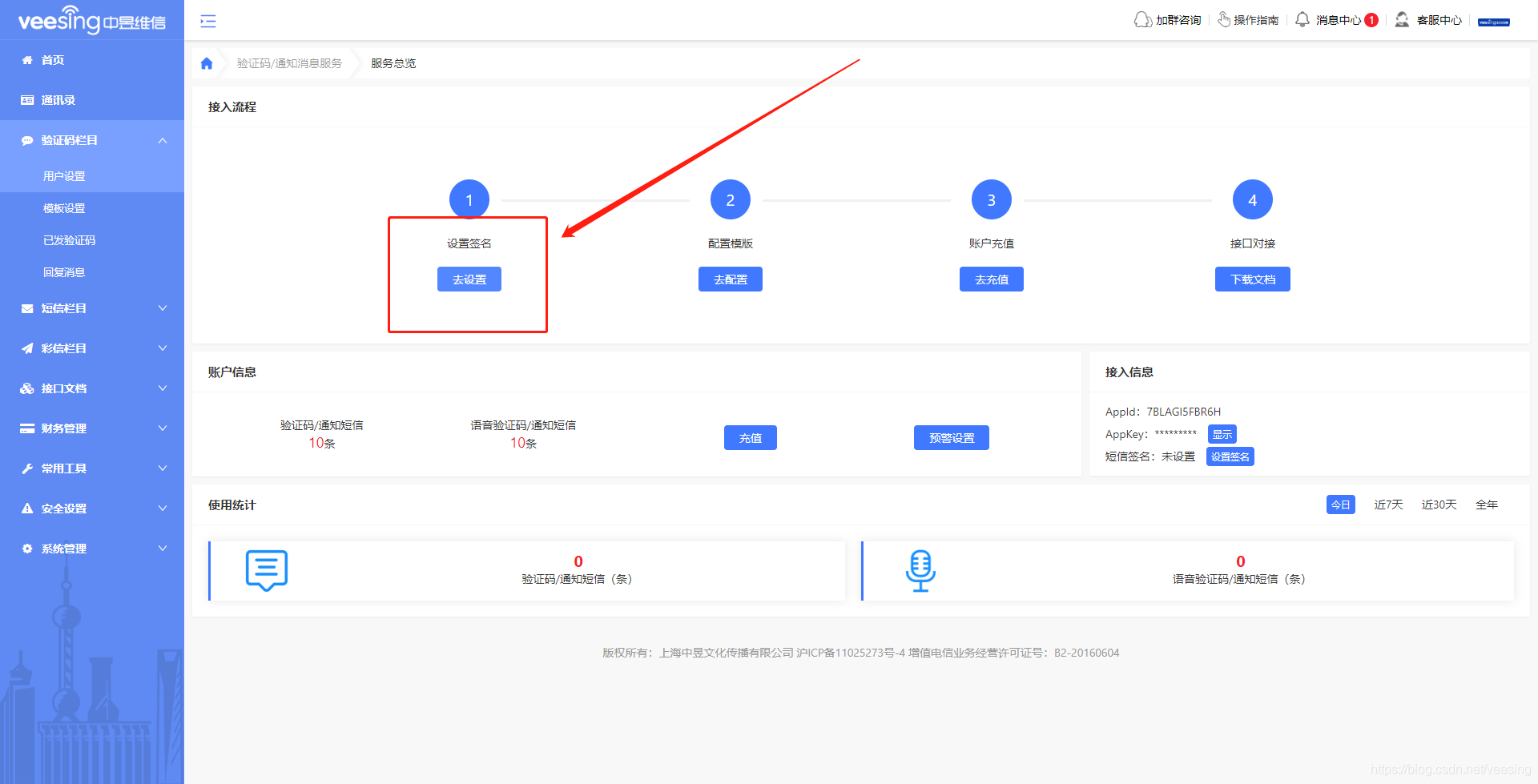一、企业短信防火墙的实现
1.1 简介
新昕科技在交易反欺诈核心上, 通过 AI 快速学习机制,结合国际领先的设备指纹技术,首次推出无需图形验证码机制的企业短信防火墙,三步完成下载对接。
1.2 第一步:获取防火墙帐号密钥
进入 防火墙控制台,在左侧导航栏选择【网站管理】,进入网站管理页面,单击【发到邮箱】接收密钥。
1.3 第二步:下载防火墙服务器
前往新昕科技官网,在顶部导航栏选择【解决方案】>【下载中心】,进入下载中心页面,找到短信防火墙服务器安装包,点击【下载链接】即可下载。
1.4 第三步:业务系统前后端接入
web 前端接入:
前端接入:
Web 前端接入文档
Java 在页面合适的位置(标签内)加入以下代码引入 JS 文件:
<script type="text/javascript" src="/NxtJsServlet"></script>
复制代码
PHP 在页面合适的位置(标签内)加入以下代码引入 JS 文件:
<script id="finger" type="text/javascript" src="/nxt_inc/nxt_front.php"></script>
复制代码
后端接入:
Java
修改配置(和业务系统同系统不需要修改):
newxtc.ini (存放位置:"/WEB-INF/classes/newxtc.ini")
修改参数(fireWareUrl)--> fireWareUrl=http://localhost:7502
短信下发
public RetMsg smsSend(HttpServletRequest request, HttpServletResponse response, String clientMobile) { RetMsg retMsg = new RetMsg(-1, "系统异常"); FwClient fwClient = new FwClientImpl(); try { // 1 调用【短信防火墙】短信发送请求 HashMap < String, Object > paramMap = fwClient.getSendReq(request, clientMobile); String jsonReq = fwClient.execReq(paramMap); String smsSendRet = fwClient.getRetVaule(jsonReq, "riskResult"); if("REJECT".equals(smsSendRet)) { retMsg.setRet(3); retMsg.setMsg("请求过于频繁"); } else { // 业务 TODO // 业务调用短信接口 TODO // 调用短信接口 结束 if(smsRetMsg != null && smsRetMsg.getRet() == 0) { // 2 调用【短信防火墙】成功结果 fwClient.execSucc(paramMap); logger.debug("send succ"); retMsg.setRet(0); retMsg.setMsg("发送验证码成功"); } else { // 2 调用【短信防火墙】失败结果 SmsVerifyCache.getInstance().remove(clientMobile); fwClient.execFail(paramMap); retMsg.setRet(-1); retMsg.setMsg("发送验证码失败"); } } } catch(Exception e) { for(StackTraceElement elment: e.getStackTrace()) { logger.error(elment.toString()); } } return retMsg;}
复制代码
短信验证
public RetMsg smsVerify(HttpServletRequest request, HttpServletResponse response, String clientMobile, String smsVerifyCode) { FwClient fwClient = new FwClientImpl(); RetMsg retMsg = new RetMsg(-1, "系统异常"); if(smsVerifyCode == null || smsVerifyCode.isEmpty()) { retMsg.setRet(1); retMsg.setMsg("输入验证码为空"); } else { // 1 调用【短信防火墙】验证请求 HashMap < String, Object > paramMap = fwClient.getVerifyReq(request, clientMobile); // 请求防火墙 String jsonReq = fwClient.execReq(paramMap); // 报文处理 String smsSendRet = fwClient.getRetVaule(jsonReq, "riskResult"); if("REJECT".equals(smsSendRet)) { retMsg.setRet(3); retMsg.setMsg("请求过于频繁"); } // 业务 TODO if(cacheSmsVerify != null && cacheSmsVerify.getVerifyCode() != null && !cacheSmsVerify.getVerifyCode().isEmpty()) { if(cacheSmsVerify.getVerifyCode().equals(smsVerifyCode)) { retMsg.setRet(0); retMsg.setMsg("验证成功"); } else { retMsg.setRet(1); retMsg.setMsg("验证码错误"); } } else { retMsg.setRet(-9); retMsg.setMsg("验证码超时"); } if(retMsg.getRet() == 0) { // 2 调用【短信防火墙】成功结果 fwClient.execSucc(paramMap); } else { // 2 调用【短信防火墙】失败结果 fwClient.execFail(paramMap); } } return retMsg;}
复制代码
PHP
修改配置文件(和业务系统同系统不需要修改):
nxtini.php (存放位置:"\nxtinc")
修改参数($GLOBALS ["fireWareUrl"])-->$GLOBALS ["fireWareUrl"]="http://localhost:7502"
短信下发
require_once $_SERVER['DOCUMENT_ROOT']."/nxt_inc/nxt_client.php";/** * 发送短信 * @param $mobile */publicfunction send(string $mobile) { $fwClient = new ClientApi(); // 获取下发短信报文 $paramMap = $fwClient - > getSendReq($phone); // 执行下发短信请求 $jsonReq = $fwClient - > execReq($paramMap); $fwRet = $fwClient - > getRetVaule($jsonReq, "riskResult"); if("REJECT" != $fwRet) { // 发送短信业务 TODO if(发送成功标记) { // 下发短信成功 $fwClient - > execSucc($paramMap); } else { // 下发短信失败 $fwClient - > execFail($paramMap); } }}
复制代码
短信验证
/** * 短信验证 * @param $mobile */publicfunction smsVerify(string $mobile) { $fwClient = new ClientApi(); // 获取短信验证报文 $paramMap = $fwClient - > getVerifyReq($phone); // 执行短信验证请求 $jsonReq = $fwClient - > execReq($paramMap); $fwRet = $fwClient - > getRetVaule($jsonReq, "riskResult"); if("REJECT" != $fwRet) { // 验证短信业务 TODO if(验证成功标记) { // 验证短信成功 $fwClient - > execSucc($paramMap); } else { // 验证短信失败 $fwClient - > execFail($paramMap); } }}
复制代码
1.5 丰富可视化实时风险大盘
防御拦截数据尽收眼底,实时查看当日数据详情与近期风险趋势。
通过风控数据看板,可查看 1-30 天的验证情况、风控拦截情况以及验证事件触发的 AI 模型情况。
进入防火墙控制台,在左侧导航栏选择【风险大盘】,进入风险大盘页面。
二、短信验证码的实现
2.1 简介
企业防火墙只能防止机器人脚本恶意攻击网站或 App,如何识别到是本人操作的,还需要结合短信验证码进一步进行身份识别。本文以注册为例,在 SpringMVC+Spring+Mybatis 框架的基础上完成该短信验证码功能。
发送短信验证码的原理是:随机生成一个 4-6 位数字,将该 4-6 位数字保存到 session 当中,客户端通过 sessionid 判断对应的 session,用户输入的验证码再与 session 记录的验证码进行比较。
一般的第三方短信平台都会有他们自己的短信接口,只要读懂他们的接口稍作稍作改变就能满足自己的需求。
首先将短信平台接口代码列出:这里需要依赖的三个通用 jar 包 commons-logging-1.1.1.jar,commons-httpclient-3.1.jar,commons-codec-1.4.jar。
2.2 短信服务商接入
开发短信验证码功能通常是采用第三方短信服务商的服务,作为短信下发渠道,以这个网站短信验证码为例:上海中昱文化传播有限公司【简称中昱维信】。获取试用验证码条数和验证码接口文档,进行接口对接前需首先进行准备工作:
短信签名报备
短信验证码需预先设置短信签名,签名会经过平台审核,审核通过后才可作为接口参数使用。
短信验证码模板报备
短信验证码需预先设置短信模板,签名会经过平台审核,审核通过后才可作为接口参数使用。
获取 appId 和 appKey
为保障接口安全,短信验证码接口,使用多重加密的 appId 和 appKey 进行身份鉴权和校验,这两个字段作为验证码接口必填项,建议预先获取到,获取 appKey 时需要对注册人进行身份校验。
至此,短信服务商验证码接口已经准备完毕,接下来可以进行业务场景,进行短信验证码服务的开发,下面展示通用的短信验证码接入流程。
2.3 短信验证码代码实现
短信验证码前端较为简单,主要就是发送验证码和校验验证码两个 ajax 请求,结合上面的滑动验证可实现双重验证。前端页面结构如下:
<html> <head> <meta charset="utf-8"/> <meta name="viewport" content="width=device-width, initial-scale=1.0, maximum-scale=1.0, minimum-scale=1.0, user-scalable=0"> <!-- 国内使用 --> <link rel="stylesheet" href="https://cdn.staticfile.org/amazeui/2.7.2/css/amazeui.min.css"> <script type="text/javascript" charset="utf-8" src="https://cdn.staticfile.org/jquery/3.3.1/jquery.min.js"></script> </head> <body> <div class="am-form"> <div class="am-form-group"> <label for="tel">请输入手机号</label> <input type="text" class="" id="tel" placeholder="请输入手机号"> </div> <div id="__nc" style="height: 70px"> <div id="nc"></div> </div> <div class="am-form-group"> <label for="code">请输入验证码</label> <input id="code" type="text" placeholder="请输入验证码"> </div> <button type="button" class="am-btn am-btn-primary">提交</button> </div> <script> var nc_token = ["CF_APP_1", (new Date()).getTime(), Math.random()].join(':'); var nc=NoCaptcha.init({ renderTo: '#nc', appkey: 'CF_APP_1', scene: 'register', token: nc_token, trans: {"key1": "code200"}, elementID: ["usernameID"], is_Opt: 0, language: "cn", timeout: 10000, retryTimes: 5, errorTimes: 5, inline:false, apimap: { // 'analyze': '//a.com/nocaptcha/analyze.jsonp', // 'uab_Url': '//aeu.alicdn.com/js/uac/909.js', }, bannerHidden:false, initHidden:false, callback: function (data) { window.console && console.log(nc_token) window.console && console.log(data.csessionid) window.console && console.log(data.sig); var tel = $('#tel').val(); $.ajax({ url: "sendCode", type: "post", data: { tel:tel }, dataType: "json", success: function (result) { if (result.code == 0) { alert("验证码已发送!", "green") } else { alert("发送失败,请稍后再试!"); nc.reset() } }, error: function () { alert("系统繁忙,请稍后再试!", "red") } }) }, error: function (s) { } }); NoCaptcha.setEnabled(true); nc.reset();//请务必确保这里调用一次reset()方法 NoCaptcha.upLang('cn', { 'LOADING':"加载中...",//加载 'SLIDER_LABEL': "请向右滑动验证",//等待滑动 'CHECK_Y':"验证通过",//通过 'ERROR_TITLE':"非常抱歉,这出错了...",//拦截 'CHECK_N':"验证未通过", //准备唤醒二次验证 'OVERLAY_INFORM':"经检测你当前操作环境存在风险,请输入验证码",//二次验证 'TIPS_TITLE':"验证码错误,请重新输入"//验证码输错时的提示 }); </script> </body> </html>
复制代码
后端代码主要职责是两方面:1)接收生成验证码请求,生成验证码存入 session 中;2)接收校验验证码的请求,将存入 session 的验证码去除,与前端输入的验证码进行比对,比对一致则通过并进行视图转发,比对不一致则告知前端错误原因。主要实现代码如下:
HttpSession session = req.getSession(); // 验证码有效时间 session.setMaxInactiveInterval(600); try { Integer num = RandNumber.getNum(); // 发送验证码通道 Sendsms.Send(num, phone); session.setAttribute(phone, num); return R.ok(); } catch (Exception e) { e.printStackTrace(); logger.error(e.getMessage()); return R.error("fasle"); }
import java.io.Exception; import org.apache.commons.httpclient.HttpClient; import org.apache.commons.httpclient.HttpException; import org.apache.commons.httpclient.NameValuePair; import org.apache.commons.httpclient.methods.PostMethod; public class Sendsms { private static String Url = "https://vip.veesing.com/smsApi/verifyCode"; // 发送短信验证码 public static void Send(Integer num, String mobile) { try { HttpClient client = new HttpClient(); PostMethod method = new PostMethod(Url); client.getParams().setContentCharset("UTF-8"); method.setRequestHeader("ContentType", "application/x-www-form-urlencoded;charset=UTF-8"); NameValuePair[] data = { new NameValuePair("appId", "*********"), new NameValuePair("appKey", "**********"), new NameValuePair("templateId", "*******"), new NameValuePair("mobile", "*******"), new NameValuePair("variables", "*******") }; method.setRequestBody(data); client.executeMethod(method); String submitResult = method.getResponseBodyAsString(); System.out.println(submitResult); } catch (Exception e) { e.printStackTrace(); } } }
HttpSession session = req.getSession(); String yzm = String.valueOf(session.getAttribute(username)); logger.info(yzm); if (yzm == null) { return R.error("验证码错误"); } if (yzm != null && !verifycode.equals(yzm)) { return R.error("验证码错误"); }
复制代码
以上就是 Java 实现企业短信防火墙与短信验证码的全部实现,基于此案例,可实现安全性高、用户体验好的登录注册+企业短信防火墙+短信验证码功能。
原地址:短信接口被恶意调用?【新昕科技】企业短信防火墙+【中昱维信】短信验证码【Java应用实例】
这篇文章到这里就结束了,感谢大佬们驻足观看,大佬们点个关注、点个赞呗~
谢谢大佬~
作者:香芋味的猫丶


















评论